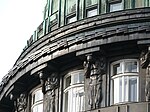art.wikisort.org - Artist
Franz Metzner (18 November 1870, Wscherau, near Plzeň – 24 March 1919, Berlin) was an influential German sculptor, particularly his sculptural figures integrated into the architecture of Central European public buildings in the Art Nouveau / Jugendstil / Vienna Secession period. His style is difficult to classify.

Biography

Metzer learned the craft of stone-cutting in Breslau with Christian Behrens and did apprenticeships in Saxony through 1894. He founded his own studio in Berlin in 1896 and worked predominantly for the royal porcelain factory until 1903, and became a professor at the Vienna college of arts and sciences. Metzner achieved fame by winning a gold medal at the Paris Exposition Universelle (1900).
Among his important works are the sculptures for Josef Hoffmann's 1904–1911 landmark Vienna Secession Palais Stoclet in Brussels, including the eccentric four green male nudes at the summit of the building. The Palais Stoclet is an example of "Gesamtkunstwerk", the integration of art and architecture, one of the goals of Jugendstil, and it had notable influence on birth of Art Deco.[1]
In 1910 Metzner met the vacationing Frank Lloyd Wright and, according to the scholarship of Anthony Alofsin, Metzer affected Wright's "conventionalization" of the human figure and its incorporation into buildings like the Larkin Building and Midway Gardens. Around the same time, Metzner's designs influenced Czech artists working in Prague, Stanislav Sucharda among them.
A famous work is the 1913 Völkerschlachtdenkmal (People's Battle Monument), designed by the architect Bruno Schmitz in Leipzig. Metzner executed the powerful and strangely scaled interior figural-architectural sculpture in the "Hecker Tomb" with his teacher Behrens. The Monument was inaugurated in 1913 by Kaiser Wilhelm II. It is unique and imposing combination of Wilhelmine and Jugendstil styles.[2]
Much of Metzner's work in Germany was lost in World War II.
Other work
- Atlas figures, Zacherl House, Vienna, Austria, 1905, Jože Plečnik, architect
- Tomb for the paper manufacturer Max Krause in the Jerusalem Cemetery in Berlin, 1907, Bruno Schmitz architect
- Franz Stelzhammer Monument, Linz, Germany, 1908
- sculpture for the Ufa-Pavillon am Nollendorfplatz in Berlin, 1913, for architect Oskar Kaufmann
- Der Rüdigerbrunnen (the Rudiger well) in the Bavarian city of Kaufbeuren
- Atlas figures (1905), Zacherl House, Vienna, Austria, Jože Plečnik, architect.
- Der Rüdigerbrunnen (the Rudiger well), Kaufbeuren, Germany.
- Franz Stelzhammer Monument (1908), Linz, Germany.
- Voelkerschlachtdenkmal (1898-1913), Leipzig, Germany, Bruno Schmitz, architect.
- Wächterfiguren (Guards), encircling the dome of the Völkerschlachtdenkmal.
- Interior of the dome of the Völkerschlachtdenkmal.
- Masks of Fate, crypt of the Völkerschlachtdenkmal.
References
- "Stoclet House". UNESCO. Retrieved 24 July 2019.
- Klaus-Jürgen Sembach (2002). Art Nouveau. Taschen. pp. 37, 38. ISBN 9783822820223. Retrieved 24 July 2019.
Further reading
- Einholz, Sibylle. "Metzner, Franz." In Grove Art Online. Oxford Art Online, (accessed 4 February 2012; subscription required).
- Metzner, Franz. In: Ulrich Thieme, Felix Becker et al.: Allgemeines Lexikon der Bildenden Künstler von der Antike bis zur Gegenwart. Vol. 24, E. A. Seemann, Leipzig 1930, p. 448f.
External links
 Media related to Franz Metzner at Wikimedia Commons
Media related to Franz Metzner at Wikimedia Commons- Entry for Franz Metzner on the Union List of Artist Names
- Literature by and about Franz Metzner in the German National Library catalogue
На других языках
[de] Franz Metzner (Bildhauer)
Franz Metzner (* 18. November 1870 in Wscherau, Österreich-Ungarn; † 24. März 1919 in Zehlendorf[1]) war ein österreichischer Steinmetz und Bildhauer, der lange Zeit in Berlin lebte und arbeitete. Seine Kunst stand in der Tradition des Symbolismus und der Wiener Secession. Er gestaltete seine Monumentalfiguren schlicht, ausdrucksstark und auf das Wesentliche reduziert.- [en] Franz Metzner
[es] Franz Metzner
Franz Metzner (18 de noviembre de 1870, Wscherau, cercanías de Pilsen - 24 de marzo de 1919, Berlín) fue un influyente escultor alemán, particularmente por sus figuras escultóricas integradas en la arquitectura de edificios públicos de Europa Central en el periodo Art Nouveau / Jugendstil / Secesión de Viena. Su estilo es difícil de clasificar.[fr] Franz Metzner
Franz Metzner (1870-1919) est un tailleur de pierre et sculpteur autrichien. Collaborateur au Wiener Werkstätte, marqué par le symbolisme, il travailla longtemps à Berlin.[ru] Мецнер, Франц
Франц Мецнер (нем. Franz Metzner; 18 ноября 1870, г. Вшерубы недалеко от г. Пльзень (ныне района Пльзень-север Пльзенского края Чешской Республики) — 24 марта 1919, Берлин) — австрийский скульптор, длительный период времени живший и работавший в Берлине. Представитель символизма и венского сецессиона.Другой контент может иметь иную лицензию. Перед использованием материалов сайта WikiSort.org внимательно изучите правила лицензирования конкретных элементов наполнения сайта.
WikiSort.org - проект по пересортировке и дополнению контента Википедии






